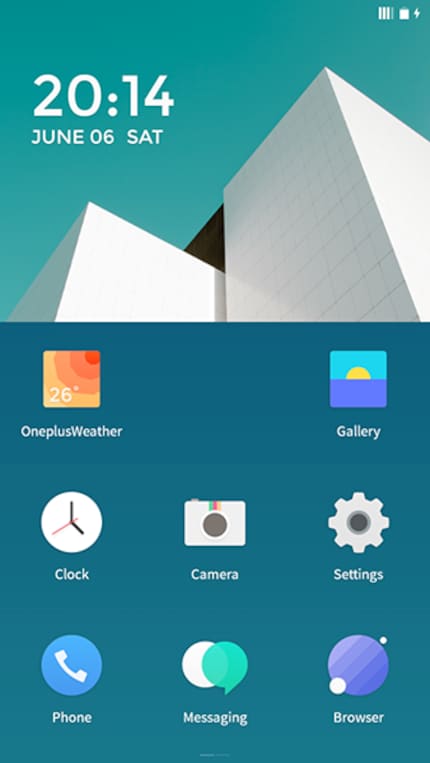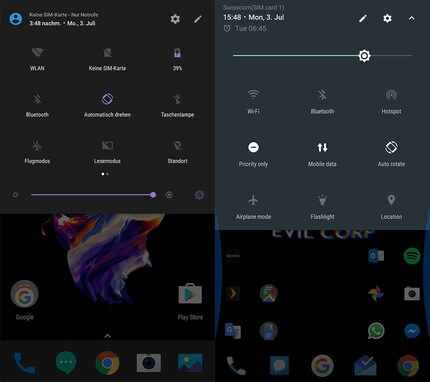
OnePlus 5: Fast, twisted and without frills
Cheap iPhone clone or tough competition for the apple from the Android camp? The OnePlus 5 is the subject of controversial debate. I took a close look at the phone. My realisation: The OnePlus 5 has enormous power and knows how to use it.
I notice one thing as soon as I unpack the OnePlus 5: I expect a certain feel, but I get a different one. The new flagship from China looks rounded, but feels much more angular than it appears. Only at second glance do I realise that there is an edge that is almost swallowed up by the matt black surface.
In the course of my testing, however, I quickly got used to the fact that the phone feels more angular than it looks. After all, a smartphone is not something you look at very often. You look at the content displayed on the screen, but not at the device itself. Maybe right after the purchase. Because there's a lot to see on the OnePlus 5. There's an extra button on the left-hand side. The button, which is actually a slider, can switch your phone into three modes.
- Loud
- Please do not disturb
- Silent
Nice. Sure, we already know the feature, but still: nice. Just because something isn't particularly innovative doesn't mean it's bad. It's something I have to remind myself of every now and then. As a smartphone critic on duty, it's easy to become cynical.
After the surprise with the edge, the boot process follows... and is also immediately finished again. The OnePlus 5 is really fast. From zero to ready to use, the smartphone takes just under 15 seconds when it boots up. I am very impressed.
What the hell is OxygenOS? Isn't that Android?
Fans of the Chinese brand OnePlus swear by OxygenOS, the brand's operating system. People who actually just want a phone can't do much with the term or, in the worst case, are even put off by the name. That's why I once again went behind the great firewall of China in search of clues and did some research.

OxygenOS is an Android version. In the original Chinese, it is called 氧OS. In Pinyin, the Latin phonetic transcription of Chinese characters, it is called yǎng OS. OxygenOS was developed for the Western market, which means that a different version is installed in China. The Chinese version is called HydrogenOS, 氢OS. In pinyin qīng OS. Last September, the news and coding platform xda-developers referred to Chinese sources who said that HydrogenOS and OxygenOS should have been merged.
OxygenOS, on the other hand, looks and feels much more like stock Android. Stock Android is the version of Android that is distributed directly by Google. Most manufacturers take stock and modify the open-source software to add new features, change graphic elements and pre-install apps.
In the case of OxygenOS, this is particularly evident in the fact that the colour scheme of the highlights is purple by default and the icons of the apps have been changed.

OxygenOS (left) and the stock Android version of the HTC U 11
Be that as it may, the Android version is not the controversial thing about the OnePlus 5. That's the obvious similarity to the iPhone 7.
The similarity with Apple
As soon as the first 3D models of the OnePlus 5 were released to the public, the first comparisons with the iPhone 7 were made. The devices are too similar and I would be surprised if Apple didn't complain. I wouldn't be surprised if OnePlus has changed just enough that the lawsuit will come to nothing, even if Apple manages to somehow legally get the defendant out of the Chinese jurisdiction.
But does that mean the OnePlus 5 is bad? Not at all, because the obvious role model already does a lot of things well and there are few phones that feel as good as the 188 gram iPhone. However, the OnePlus 5 is considerably lighter at 153 grams and has the strange edge that is visually unnoticeable.
An English proverb says: Imitation is the sincerest form of flattery. Imitation is the sincerest form of flattery. And the OnePlus 5 probably proves that Apple is doing a lot right with its form factor. I agree with that. Whether you find that good, bad or amusing, I'll leave that up to you. Because even if the devices look similar, they feel completely different.
Jelly scrolling and the upside-down screen
The launch of the OnePlus 5 is overshadowed by a completely different scandal. The strange behaviour of the phone is called jelly scrolling. The behaviour goes like this: When you scroll in an app like Instagram, the image at the edge of the screen warps. It's barely noticeable, but once you've seen it, you can't unsee it, much like the arrow in the Fedex logo.

Of course, users and hackers have been poring over the phone and trying to explain the behaviour. At the time of going to press, the theory that the screen of the OnePlus 5 has been rotated by 180 degrees persists.
The investigation on xda-developers speaks in favour of this. However, according to the investigation, this is not a mistake, but a deliberate decision when designing and building the phone. It is not clear why this was done, but it is consistent with the statements of the Chinese company, which continues to claim that its phone works as the developers intended. This doesn't happen by accident.
But: It has not yet been proven that this design leads to jelly scrolling.
The problem arises when you look at how OnePlus communicates. In a statement, OnePlus says the following:
The OnePlus 5 uses the same level of high-quality components as all OnePlus devices, including the AMOLED display. We've received feedback from a small number of users saying that at times they notice a subtle visual effect when scrolling. This is natural and there's no variance in screens between devices.
In German:
The OnePlus 5 uses the same high-quality parts as all OnePlus devices, including the AMOLED display. A small number of our users have reported that they notice a subtle visual effect when scrolling. This is by design and there are no differences from device to device.
But unfortunately, only some users report jelly scrolling. Others do not notice the effect. The investigation continues. The source code of the OnePlus 5 is taken apart. Spurred on by the discovery that jelly scrolling can be imitated by turning some smartphones upside down and rotating the screen, they searched the source code for lines that have something to do with text and image alignment.
- qcom,mdss-dsi-panel-orientation: String used to indicate orientation of panel "180" = panel is flipped in both horizontal and vertical directions "hflip" = panel is flipped in horizontal direction "vflip" = panel is flipped in vertical directionand
//qcom, mdss-tear-check-start-pos= <1920>; /* Height */
//qcom, mdss-tear-check-rd-ptr-trigger-intr = <1921>; /* Height +1 */
qcom,mdss-dsi-panel-orientation = "180";
qcom,mdss-dsi-high-brightness-panel;
qcom,mdss-dsi-panel-acl-command = [15 01 00 00 00 00 02 55 00];This was found by xda-developers member Sultanxda. This proves that OnePlus has not changed anything about the AMOLED screen technology used, but has simply rotated the screen by 180 degrees. Whether this is responsible for the jelly scrolling or not has not yet been proven. However, the suspicion is growing stronger. Especially because, according to pocketnow.com, the speakers are also rotated by 180 degrees. However, this at least can easily be fixed on the software side.
One note: The phone I tested on does not have the jelly scrolling effect.
But now: The OnePlus 5 in use
OnePlus took a lot of risks when building the OnePlus 5 and cut corners here and there, which is now biting them in the arse. Especially with regard to the, shall we say, creative decisions made when aligning the components. Nevertheless, what counts in the end is not a display whose direction has been changed, but the phone in use. And the answer to the question: Is it worth buying?
The OnePlus 5 is slightly more expensive than its predecessors, but in terms of system specs, you still get a lot of phone for very little money. The RAM in particular is noticeable. I've tried a lot, but the phone just hasn't got any slower. There's not much more to say, apart from the fact that the OnePlus 5 is a real powerhouse. No matter what you want to do, it's fast. Very fast.
The camera also shoots great pictures, also very quickly and without frills. Sure, bells and whistles can be set, but when you start up the camera, it takes practically no time at all. If you find a waiting time somewhere, let me know.

Despite all the controversies and minor scandals and everything: I like the OnePlus 5. It does a lot, costs little, feels good in the hand and looks chic. The only thing that could be criticised is that OnePlus is bringing out a new phone but not reinventing anything. This is the year of the format change, infinity displays and biometrics. OnePlus could get involved, but doesn't want to. The critic in me, the tech fan, wants new features. I wonder what the Chinese would do if they would just work and try things out. I saw glimpses of this mindset at the MWC in Barcelona and it was very, very exciting.

OnePlus delivers a solid phone. Because everything it does, it does very well and very quickly. It does exactly what I want it to do, when I want it to do it and doesn't have any superfluous features. The Android version doesn't need much decoration. The phone is minimalist by design and I really like that.
Journalist. Author. Hacker. A storyteller searching for boundaries, secrets and taboos – putting the world to paper. Not because I can but because I can’t not.